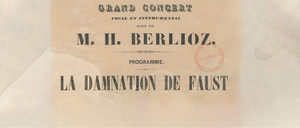Review: BERLIOZ's DAMNATION OF FAUST Returns To The Met

Saturday afternoon saw the return of Berlioz's DAMNATION OF FAUST to the Met, not seen there since 2009. Because of logistical considerations it was mounted in concert form on the stage rather than in Robert Lepage's previous staging. The concert style proved to be an extremely effective format for what Berlioz called a "legende dramatique", a work that did not neatly fit into either the opera or oratorio category.
The work is essentially a series of scenes based on Goethe's epic FAUST. Locales range from a plain in Hungary for the first scene, to a tavern in Leipzig, a meadow on the Elbe River, where Faust first learns of Marguerite, to a raucous trip to the netherworld courtesy of Mephistopheles himself.
DAMNATION premiered in Paris in 1846 in a concert version, Berlioz realizing it would be difficult to stage. The first staged version did not occur until 1893, after the composer's death.
The Met premiere, also in concert form, occurred in 1896, it's first staging there ten years later.
The Met mounted two concert performances in the 1990's and then presented it's second staging of the piece in 2008 by Lepage.
The opera is scored for four soloists, orchestra, and both adult and children's choruses. The orchestra has most of the heavy lifting since Berlioz was primarily an avid orchestrator; listen to his SYMPHONIE FANTASTIQUE for a great example of his talents in this regard. Although there are a few orchestral moments that are performed separately in the concert hall (such as the "Hungarian March" and the "Minuet of the Will-o-the Wisps"),most of the score needs to be heard in context.
The storyline is centered around the Faust-Marguerite romance but by having other locales in addition to those germane to the love story, Berlioz hews more closely to Goethe's epic than does Gounod's more popular opera FAUST.
Saturday's cast was extremely strong and centered on the return of the wonderful heroic tenor Bryan Hymel after many seasons. He is a great Berlioz tenor and is remembered for rescuing a revival of LES TROYENS a few years ago, on short notice. He has also performed Rodolfo, Pinkerton, and Arnold in WILLIAM TELL. He coped well with the treacherous tessitura of Berlioz's Faust, his muscular voice having no trouble being heard over the large orchestra.
Marguerite was sung by Latvian mezzo Elina Garanca, who is steadily moving from the Rossini and Donizetti repertory to heavier roles such as Santuzza and Eboli. Her voice is large, flexible, and has a beautiful tone that projects well. Her second act aria was heartbreakingly sung.
Mephistopheles was sung by Ildar Abdrazakov, who had sung the role here before. He was a stern, commanding Devil, and utilized his strong, but lyrical bass voice to chilling effect. The "Ride to the Abyss", where he takes Faust to the underworld was a highlight of the afternoon.
Patrick Carfizzi brought his considerable talents to the role of Brander in his Act One aria. He brings great style to everything he sings.
One wonders whether opera in concert form is possibly one answer to the ever-burgeoning cost of producing opera these days. It does allow the audience to concentrate on what the composer wants us to really care about: libretto and music. With directors nowadays so often placing their vision of a work over what the composer originally intended, concert performances may help restore that balance. Saturday's performance strengthens that argument.
Add Your Comment
Videos


